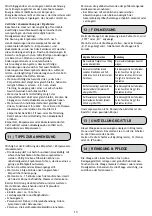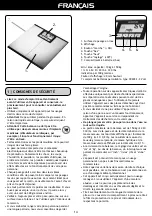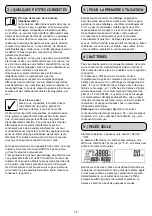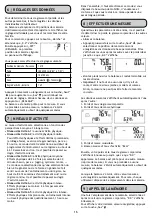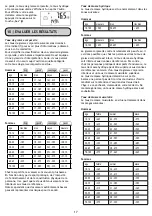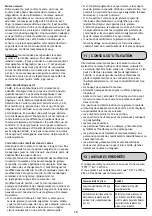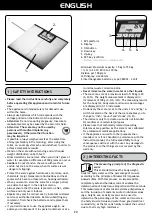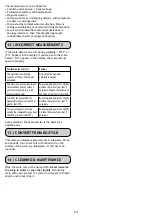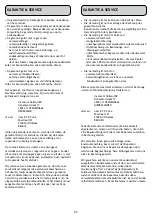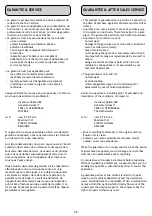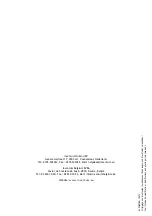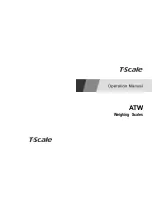
Body fat contains relatively little water. Therefore
persons with a high body fat percentage have body water
percentages below the recommended values. With
endurance athletes, however, the recommended values
could be exceeded due to low fat percentages and high
muscle percentage.
Body water measurement with this scale is not suitable
for drawing medical conclusions, for example concerning
age-related water retention. If necessary ask your
physician. Basically, a high body water percentage should
be the aim.
Muscle percentage
The muscle percentage is normally within the following
ranges:
man
Age
low
normal
high
10-14
< 44%
44 - 57%
> 57%
15-19
< 43%
43 - 56%
> 56%
20-29
< 42%
42 - 54%
> 54%
30-39
< 41%
41 - 52%
> 52%
40-49
< 40%
40 - 50%
> 50%
50-59
< 39%
39 - 48%
> 48%
60-69
< 38%
38 - 47%
> 47%
70-100
< 37%
37 - 46%
> 46%
female
Age
low
normal
high
10-14
< 36%
36 - 43%
> 43%
15-19
< 35%
35 - 41%
> 41%
20-29
< 34%
34 - 39%
> 39%
30-39
< 33%
33 - 38%
> 38%
40-49
< 31%
31 - 36%
> 36%
50-59
< 29%
29 - 34%
> 34%
60-69
< 28%
28 - 33%
> 33%
70-100
< 27%
27 - 32%
> 32%
Bone mass
Like the rest of our body, our bones are subject to
the natural development, degeneration and ageing
processes. Bone mass increases rapidly in childhood and
reaches its maximum between 30 and 40 years of age.
Bone mass reduces slightly with increasing age. you
can reduce this degeneration somewhat with healthy
nutrition (particularly calcium and vitamin D) and regular
exercise. With appropriate muscle building, you can
also strengthen your bone structure.
note that this scale will not show you the calcium
content of your bones, but will measure the weight of
all bone constituents (organic substances, inorganic
substances and water).
Attention:
Please do not confuse bone mass with bone
density. Bone density can be determined only by means
of a medical examination (e.g. computer tomography,
ultrasound). It is therefore not possible to draw
conclusions concerning changes to the bones and bone
hardness (e.g. osteoporosis) using this scale.
Little influence can be exerted on bone mass, but it
will vary slightly within the influencing factors (weight,
height, age, gender).
AMR = Active Metabolic Rate
The energy consumption of a human being rises with
increasing physical activity and is measured on the
diagnostic scale in relation to the degree of activity
entered (1-5). To maintain your existing weight, the
amount of energy used must be reintroduced into the
body in the form of food and drink. If less energy is
introduced than is used over a longer period of time,
your body will obtain the difference largely from the
amount of fat stored and your weight will reduce. If, on
the other hand, over a longer period of time more energy
is introduced than the total active metabolic rate (Amr)
calculated, your body will be unable to burn off the
excess energy, and the excess will be stored in the body
as fat and your weight will increase.
Results in relation to time
note that it is only the long-term trend which counts.
Short period fluctuations in weight over a few days are
mostly the result of a loss of fluid.
The interpretation of the results will depend on changes
in your:
overall weight and body fat, body water and muscle
percentages, as well as on the period during which these
changes take place. rapid changes
within days must be distinguished from medium term
changes (over weeks) and long term changes (months).
A basic rule is that short term changes in weight almost
exclusively represent changes in water content, whereas
medium and long term changes may also involve the fat
and muscle percentages.
• If your weight reduces over the short term, but your
body fat percentage increases or remains the same,
you have merely lost water – e.g. after a training
session, sauna session or a diet restricted only to rapid
weight loss.
• If your weight increases over the medium term and the
body fat percentage falls or stays the same, then you
could have built up valuable muscle mass.
• If your weight and body fat percentage fall
simultaneously then your diet is working – you are
losing fat mass. Ideally you should support your diet
with physical activity, fitness or power training. By this
means, you can increase your muscle percentage over
the medium term.
Important when measuring body fat/body water/muscle
percentage:
• The measurement may only be carried out while
barefoot and it is helpful if the soles of your feet
are slightly damp. Completely dry soles can result
in unsatisfactory results, as they have insufficient
condutivity.
• Stand still during the measurement.
• Wait several hours (6-8) after unusually strenuous
activity.
• Wait approx. 15 minutes after getting out of bed so
that the water in your body can be distributed.
11 | tips
23
Summary of Contents for PW 60I BM
Page 1: ...PERSONENWEEGSCHAAL PERSONENWAAGE P SE PERSONNE SCALE...
Page 2: ...2...





